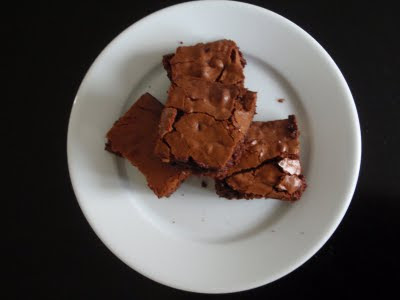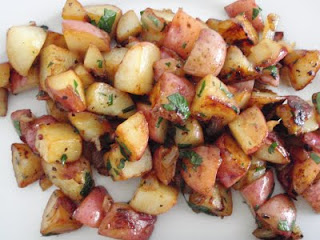
Anyone who knows me well knows that when it comes to breakfast I'm a bit, well, picky. I don't eat pizza for breakfast and I certainly don't eat cold pizza (ever, actually). I only eat "breakfast" for breakfast, if that makes sense. I never go without breakfast, but if I wake up on vacation past normal breakfast time
, so help me we
will find a place serving breakfast. It's crazy and I totally acknowledge that. Luckily, I married a man who is willing to drive long distances to find me breakfast.
As a result of my breakfast needs, I never eat leftovers (that aren't a baked good) for breakfast. Wait, scratch that.
Almost never. Polenta and an egg, I will eat. I love polenta. It's hot, creamy, inexpensive, easy to prepare, and endlessly versatile. However, my favorite thing might be frying up polenta left over from last night's dinner with an egg.

If you've never fried polenta, you must try it. I will tell you that I had many polenta frying accidents (sticking to the pan, soggy instead of crispy, etc.) until I learned that you need to
lightly dredge it in flour and then fry it in really hot oil without turning until you see a golden crust. Follow these rules and you cannot go wrong. Of course, you could serve this with dinner but have it for breakfast and it is quick enough for a weekday but it will feel special like a weekend.
Fried Polenta
Note: Use whatever oil you like (vegetable, olive, etc.) and you can even do some oil with some butter. However, because butter has a low smoke point, you shouldn't use all butter as it will burn before the polenta crisps.
Firm polenta (see recipe below)
1/3 cup all purpose flour
3-5 tablespoons of oil
1. Cut the polenta into shapes (triangles, sticks, etc.). More surface area means more crispy deliciousness, so just avoid big blocks. Put the flour on a shallow plate and lightly dredge each polenta piece in flour, shaking off excess.
2. In a large frying pan (preferably nonstick or cast-iron) heat the oil over medium-high heat. The amount of oil varies, depending on your pan, so just pour enough in to cover the bottom of the pan. When the oil is hot (you can test by dropping in a small piece of polenta or some flour... if it sizzles, it's ready) place a few pieces of the polenta in the pan. Be sure to not crowd the pan; if you're making breakfast for more than 2 people, work in batches. Don't flip the polenta until it's browned; you'll see it get golden on the edges when it's time. Really be patient as this can take 3-5 minutes. Repeat until all sides are golden and crisp. Drain on a paper towel, and serve hot with a fried egg.

Polenta
Note: I make this polenta with chicken broth, but you can certainly use water or milk, if you prefer. Also, you can add a little finely grated Parmesan at the end or herbs. Polenta is like a blank canvas that you can color however you wish.
Serves 2 with enough left over for breakfast, or 4 to serve as a side
3/4 cup yellow cornmeal (I like Bob's Red Mill, but just make sure it isn't cornmeal for cornbread, with leaveners and the like added)
2 cups low sodium chicken stock
3/4 teaspoon salt
Pinch freshly ground pepper
1 tablespoon unsalted butter
1. In a large saucepan, combine 2 cups of water, the stock, salt and pepper. Bring it to a boil over high heat. Slowly add the cornmeal in a steady stream, whisking constantly to ensure a smooth polenta with no lumps.
2. Simmer the mixture on medium low, whisking frequently until thickened. It should look a bit like hot cereal, which takes about 15 minutes. Remove from heat and whisk in the butter. Serve immediately, reserving half for fried polenta.
If you want to make fried polenta, while the polenta is still warm pour it into a square or rectangular container (such as a loaf pan or a baking pan). Cover and refrigerate until firm, which takes about 2 hours but you can keep in in the fridge for several days.
 Soup is one of my favorite things about chilly weather. I love eating it but I also love to make it... there's something about stirring a big pot of soup that feels relaxing.
Soup is one of my favorite things about chilly weather. I love eating it but I also love to make it... there's something about stirring a big pot of soup that feels relaxing. Chicken Soup for One
Chicken Soup for One













































